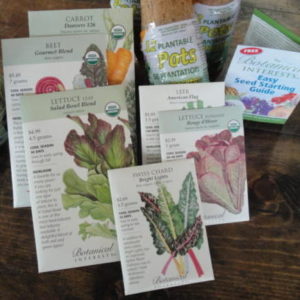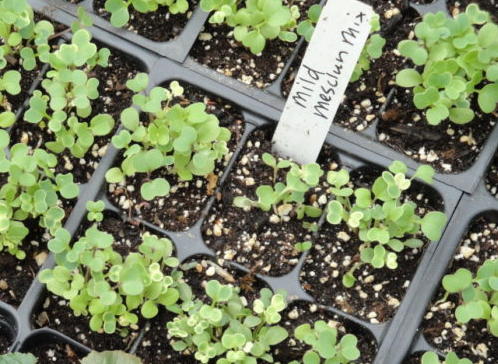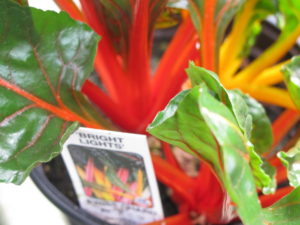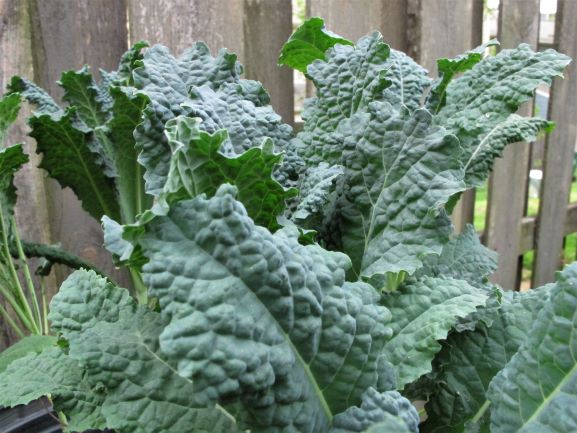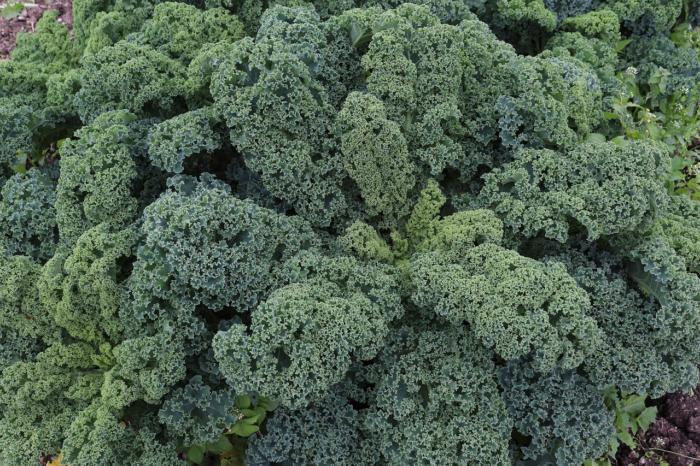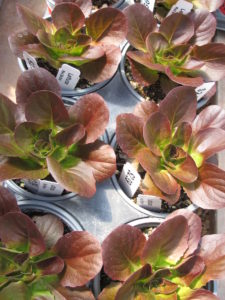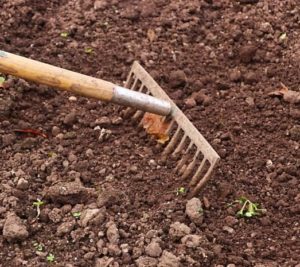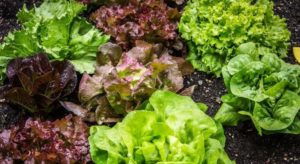Page 2
Seed or Transplant?
Seeds
Many cool season crops should be started as early as mid to late summer, for a fall crop, necessitating advance planning. That takes some discipline, considering all the weeds, bugs, and kids’ school supplies that distract us at that busy time!
Plants that take a long time to mature, such as Brussels sprouts, typically are sown in June to August for a late fall/early winter harvest. They need an early start, about 4 months before heavy frost.
A huge number of varieties are available from seed. Catalogs and seed packets include information indicating how and when to start seeds.
It’s important to know the average date of the first expected frost in autumn for your region. Knowing also when the last winter frost occurs will help you time the next round of cool season vegetables, planted in late winter to early spring, and harvested before the summer vegetables go in. Succession planting will turn you into a diligent weather watcher.
Temperature
Read the seed-starting instructions for each crop. Lettuce and cress germinate better at lower soil temperatures (50° to 65° or 70°F) than carrots, broccoli, or spinach (65° to 85°). Brussels sprouts, onions, and cabbage germinate at even higher soil temperatures (75° to 88°), allowing them enough time to mature before freezing weather arrives.
Those temperatures are the optimum ranges for these crops, assuring the most successes. Outside those ranges, germination will be low, slow, erratic, or non-existent. Feel the soil; rich, black topsoil warms up considerably in the sun, even in mildly cool weather. Shade the soil if necessary.
- Arugula ‘Astro’ seedlings.
- Mild mesclun seedlings.
- Mustard greens ‘Florida Broadleaf’.
Transplants
If the calendar indicates it’s too late for seeds, there’s another option. Garden centers and vendors at farmers’ markets sell young transplants for cool season vegetables in late summer through mid-autumn. Transplants will buy you a few to several weeks of precious time.
When I was growing seedlings for sale at year-round markets in Maryland, customers hungered for more varieties of cool season greens after discovering how easily they grew and how to prepare them in the kitchen. Most garden centers had not much more than the common autumn offerings, if they had anything at all.
Demand for cool season vegetables is growing as their nutritional benefits become more widely known. These greens, especially the brassicas (or cruciferous crops), are among the healthiest crops, but, unfortunately, often overlooked by growers and consumers.
They’re so versatile and can be added to the dishes you already prepare: veggie omelets, pasta or rice dishes, soups, stir-fries, smoothies, and salads. Even on pizza or in lasagna. Adding only one or a few leaves will significantly boost nutritional content.
More Favorites
One of my favorites is a miniature broccoli called ‘Happy Rich’ (photo, above). After harvesting the small head, with leaves and 5″ to 10″ of the tender stem, the plant will re-grow for several more harvests. All of it (head, stem, and leaves) is edible. This year, I’m trying ‘Aspabroc’ because no one grew ‘Happy Rich’ transplants and seeds were not available. (***Update***: I much prefer ‘Happy Rich’!)
Try a few varieties of miniature broccoli. While all are extremely healthy, they vary in flavor from delightfully sweet to quite bitter. The bitterness comes from sulfur compounds in the cells. I’ve heard nutrition experts say, “the more bitter, the better”, so see which ones you prefer…or can tolerate. Gai Lan is another favorite and not as “biting” as broccoli raab.
A Chinese cabbage called ‘Tokyo Bekana’ has beautiful light green leaves that add loft to salads. And it grew right through the winter without stopping. (***Update***: I’ve grown ‘Tokyo Bekana’ each year since moving to the new property. Unfortunately, each year an insect called the vegetable weevil damages the leaves. They chew multiple holes in the leaves at night and hide in the soil in the daytime. This one is hard to control. Horticultural oil gives some protection, but it can wilt the foliage on a hot day. 9/24/2024)
Komatsuna, tatsoi ‘Koji’, mustard ‘Florida Broadleaf’, and mizuna are more favorites.
In late winter, I grew the cutest little pac choi (photo, below) harvested at only 2″ in height. It makes a great gourmet presentation steamed or added whole to a brothy soup. I bought the Baker Creek Heirloom Seeds at Renfrow Hardware, a local landmark in Matthews NC; they have a good selection of seeds.
All the plants mentioned in this section are members of the antioxidant- and nutrient-dense brassica family. Because of their nutrients and phytonutrients, I’ve eaten at least one of these every day for many years.
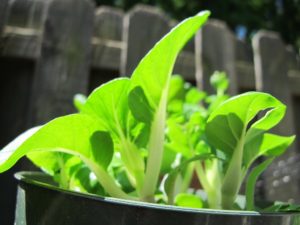
Dwarf pac choi.
Crops with Ornamental Edible Leaves
Gardeners living in the southern states or where winters are moderate can find larger pots of leafy greens from late summer through winter.
Garden centers sell dinosaur (‘Lacinato’), curly, and ‘Red Russian’ kales, colorful mustard greens, and Swiss chard in 4″ to 8″ pots as ornamental plants.
You might have seen foliage plants planted with smaller pansies and violas in commercial settings and in neighborhood gardens. Super-hardy purplish ‘Redbor’ and blue-gray dinosaur kale add height in flower beds. Their yellow flowers attract bees and beneficial insects in late winter and spring.
The colorful Swiss chard ‘Bright Lights’ and the lustrous ‘Miz America’ mustard greens tolerate some frost, but repeated hard freezes will damage the leaves. Planted where winters aren’t severe, they’re so pretty in the garden and offer pickings for the kitchen.
These crops are harvested by the leaf and continue growing until cold weather settles in. Give them shelter, though, and you’ll be able to harvest most of these crops all winter. Start with the lower or middle leaves, as long as they have good color; discard (compost) yellow or pale leaves.
Because there are fewer insects around, these ornamental edible plants are less likely to have been sprayed. But aphids can be a problem in mild weather, when they’re first offered for sale. If you intend to eat these plants, ask the grower if they’ve been sprayed.
Tender Leaf Kales
Although all the kales pictured below are edible, we prefer the faster-cooking tender-leaved types, such as ‘Red Russian’ and dinosaur (‘Lacinato’, ‘Black Magic’). Their leaves wilt almost immediately when added to hot soup or a stir-fry.
Your plants will continue to grow fresh leaves, with some protection, in moderate winters. By harvesting only what you need, there’s no waste. Kale is another member of the famously healthy Brassicaceae family.
- Dinosaur (‘Lacinato’ or ‘Toscano’) kale.
- ‘Red Russian’ kale.
- Curly leaf kale.
- Coarse-leaved ‘Redbor’ kale, with frost.
Crops That Form Heads
Heading crops (cauliflower, broccoli, cabbage, pac choi, Brussels sprouts, head lettuce) need adequate time to develop enough leaves to ensure a mature harvest. They readily respond to soil that has been amended with generous portions of compost and aged cow manure.
Stressed plants—those that are potbound, underfertilized, underwatered, or just old—form small heads or none at all. Tired cauliflower plants, for example, might grow a few small leaves before producing an unsatisfactory curd. Older transplants do not yield well, so buy only young seedlings of heading varieties.
Even though these crops are usually harvested as full heads, you can also pick some of their leaves. Take the ones lower on the stem, letting the center continue to grow. Head lettuce, pac choi, tatsoi, cabbage, and broccoli offer this limited early harvest.
Soil Fertility
Give these plants fertile ground and good drainage. Digging lots of aged manure and/or compost into the soil when planting cool season vegetables will keep them growing steadily until cold weather comes around. Sheltered crops can produce edible greens all winter, so they will need more fertilizer after the initial soil preparation. Avoid using manure with root vegetables.
Incorporate the organic material into the top 5-6″ of soil in an area over the expected width of the canopy. Amending the soil throughout the entire planting bed, instead of dropping a mere cup of bagged manure under each plant, will measurably increase the yields. If the soil has not been worked in the past, you might need to improve the drainage by first incorporating (not layering) pine fines and coarse sand in the top 12-16″ of the bed.
All of the cool season crops mentioned here require soil that is rich in nutrients, particularly nitrogen. The soil pH should be slightly acidic to slightly alkaline, around 6.3 to 7.3. I aim for a neutral 7.0. Plants growing in mild climates and in covered structures need periodic fertilization to keep them healthy. Greens are heavy feeders!
Leafy greens and vegetables respond to organic products, such as fish emulsion and Sea-Plus. They do have some odor, however, which dissipates over time. Animals might be attracted to the odor and dig around the plant.
The Importance of Microbes
Microorganisms living in the soil break down organic materials, providing simpler nutrients to plants and other organisms. They include bacteria, fungi, viruses, protozoa, and actaea. But they’re not active in cold soil. That’s why it’s important to get the soil in prime condition before planting fall crops.
Many thousands if not millions of species of microbes live in close association with roots and root hairs. Some actually penetrate root cells while others live in the rhizosphere, where soil contacts the roots. These mycorrhizal associations benefit both the plants and the microbes. In exchange for some of the sugars produced by plants, mycorrhizae can chelate minerals tightly held in soil particles and transfer them to plants. They also can absorb water and donate it to plant roots, as well as provide protection from plant pathogens.
Curiously, members of the brassica family, ericaceous plants, and a few other groups do not form symbiotic relationships with mycorrhizae. But other types of microbes decompose organic matter in the ground, contributing nutrients to all plants.
I’m not averse to occasionally using a soluble complete fertilizer in cold weather. These products have all the nitrogen, phosphorus, potassium, calcium, magnesium and micronutrients needed by most crops. Brassicas should have a small amount of boron, in particular, so check the ingredients label. Regularly using synthetic fertilizers, though, kills microbes and earthworms, so I use them only when necessary.
Nutritional Benefits

Broccoli ‘Arcadia’ in winter.
With medical reports touting the superior nutritional content of greens, wouldn’t you like to know how you can add them to your diet? They’re high in vitamins and minerals, phytonutrients, and fiber, and low in calories and fat.
Plants in the Brassicaceae family (including arugula, broccoli, Brussels sprouts, cabbage, cauliflower, collards, kale, mustard greens, turnip greens, and others) have nutrients that are not found in measurable quantities in any other crops.
The fight against inflammatory and cardiovascular diseases, cancer, and type 2 diabetes begins with your next meal. But those aren’t the only reasons to grow greens. Add to the list better skin condition, brain function, preserving eyesight, and a healthier life! I am convinced that greens—and brassicas in particular—are the healthiest foods we can eat.
It’s so easy to incorporate them into whatever you’re fixing for dinner. You can add them to store-bought canned soups, spaghetti sauce, stir-fries, salads, and even on pizza to increase nutritional content. Or, if you prefer homemade soup, try this recipe for Collards Soup. And here’s our favorite comfort food, Chicken Soup.
There are other groups of edibles to investigate. Look into spinach, beet greens, and Swiss chard (all in the Amaranthaceae family), but find out first if their oxalate content can affect you. Talk with your doctor if you are prone to developing kidney stones.
Plants in the onion family, including green onions, leeks, and especially garlic, bring their own assets to the table.
And don’t forget lettuces (Asteraceae family) for fresh salads and sandwiches. You can even add it to soup! Red lettuces are higher in anthocyanins, a group of powerful and beneficial antioxidants.
Ready For the 10 Tips? (Turn To Page 3)
Headings:
Page 1: Ready For Fall?, Where There’s a Will, There’s a Way (The Advantage Of This Latitude), and Succession Planting: Warm, Then Cool Season Vegetables (Peas, Yummy!, Gather Information)
Page 2: Seed or Transplant? (Seeds, Temperature, Transplants, More Favorites), Crops With Ornamental Edible Leaves (Tender Leaf Kales), Crops That Form Heads, Soil Fertility (The Importance of Microbes), Nutritional Benefits, and Ready For the 10 Tips?
Page 3: Tip #1: Move Tender Plants Indoors, Tip #2: “Quick! Cover Up!”, Tip #3: The Hot Water Bottle, Tip #4: Low Tunnels, Tip #5: Deal with the Wind, Tip #6: Add Christmas Lights, Tip #7: I’ll Have a Double
Page 4: Tip #8: A Simple Cold Frame For Cool Season Vegetables, Tip #9: A Lean-To, Tip #10: The Greenhouse, Finally!
